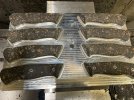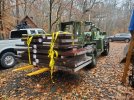What a total and utter failure of a day, lol. Some vintage Westinghouse rag Micarta definitely saw the graveyard today.

First I tried a metal cutting blade from Blade Serpent at the suggestion of a person who processes a LOT of Micarta. I was expecting it to work because of the speed of my saw, but we thought it might be worth a shot. For the first couple of inches it cut REALLY well! Then the teeth all clogged and it just burned the micarta.
Then I tried the Starrett skip tooth blade. It left a very poor finish in the Micarta, but worst of all, there was a pretty big thickness variance when going from the top to the bottom of the material. I was worried about this considering the blade is only 3/8" thick. I'm going to keep it around for rough cutting handle profiles though. It'll beat making relieve cuts on the Portaband constantly.
Then I went back to the Timberwolf blade. It made a great cut that had an even thickness all the way through, but could only make it through about one or two cuts before it was so dull it would drift a bit.
I have a 3/4" carbide blade from Sawblade.com coming in tomorrow. We'll see how that goes. If that doesn't work, I'm out of ideas for slabbing up the gears.
Maybe I should give the wet tile saw a go? They don't look to spendy, though I don't know what I'd ever use it for again. Would something like that be able to make a straight, even cut through five inches of Micarta...?
Other than that, I think I'm stuck using abrasive belts to sand the gears to thickness after cutting them in half.
Up top is the cut from the Timberwolf blade. The middle is the skip tooth. The bottom is the metal cutting blade (look how burned it is!).
The only saving grace was that I got another ~60 maple burl blocks in my ghetto kiln (I start at 80 degrees and slowly go up from there)...
And processed another ~150 redwood burl blocks. They'll go into the kiln when the moisture reading drops to around 10%.
K&G just received the four large, flat-rate boxes I shipped them the other day too.

Oh... And I picked up this WW2 era Seabee propeller made from Westinghouse Micarta.

No idea what I'm going to do with it, lol.
So.... Any other ideas on how to slab up this 48" x 5-3/8" rod of Micarta into 3/8" slabs, lol? If not a tile saw, I was thinking about looking into a water jet service?
Look at this beast compared to the 2-3/4" rod, lol.
I don't know. Agghhh.











